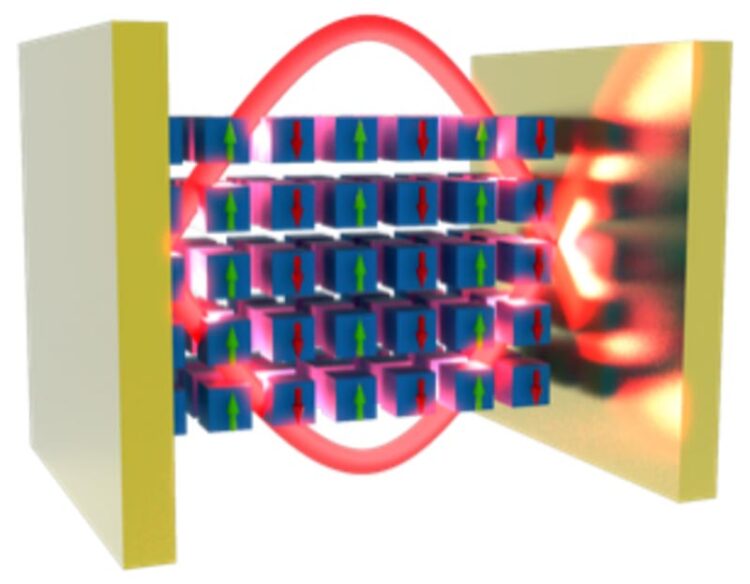CCNY researchers create new magnetic quasiparticle

Optical resonator enhanced coupling of photons and spin-correlated excitations in a van der Waals magnetic crystal. Image created by Rezlind Bushati
From The City College of New York’s Center for Discovery and Innovation and the Physics Department comes news of a new type of magnetic quasiparticle created by coupling light to a stack of ultrathin two-dimensional magnets. This achievement sprouting from a collaboration with the University of Texas at Austin lays the foundation for an emergent strategy to artificially design materials by ensuring their strong interaction with light.
“Implementing our approach with magnetic materials is a promising path towards efficient magneto-optical effects,” said CCNY physicist Vinod M. Menon, whose group led the study. “Achieving this goal can enable their use for applications in everyday devices like lasers, or for digital data storage.”
Dr. Florian Dirnberger, the lead author of the study, believes that their work exposed a largely unexplored realm of strong interactions between light and magnetic crystals. “Research in recent years brought forth a number of atomically flat magnets that are exceptionally well-suited to be studied by our approach,” he noted.
Looking ahead, the team plans to extend these investigations to understand the role of the quantum electrodynamical vacuum when quantum materials are placed into optical cavities. “Our work paves the way for the stabilization of novel quantum phases of matter that have no counterpart in thermodynamic equilibrium,” commented Edoardo Baldini, assistant professor at The University of Texas at Austin.
The development is reported in the current issue of “Nature Nanotechnology,” in a paper entitled “Spin-correlated exciton-polaritons in a van der Waals magnet.”
The research was funded by the National Science Foundation, Army Research Office and the CREST-IDEALS Center at CCNY.
Journal: Nature Nanotechnology
Method of Research: Experimental study
Article Title: Spin-correlated exciton-polaritons in a van der Waals magnet
Article Publication Date: 12-Sep-2022
All latest news from the category: Physics and Astronomy
This area deals with the fundamental laws and building blocks of nature and how they interact, the properties and the behavior of matter, and research into space and time and their structures.
innovations-report provides in-depth reports and articles on subjects such as astrophysics, laser technologies, nuclear, quantum, particle and solid-state physics, nanotechnologies, planetary research and findings (Mars, Venus) and developments related to the Hubble Telescope.
Newest articles

Innovative 3D printed scaffolds offer new hope for bone healing
Researchers at the Institute for Bioengineering of Catalonia have developed novel 3D printed PLA-CaP scaffolds that promote blood vessel formation, ensuring better healing and regeneration of bone tissue. Bone is…

The surprising role of gut infection in Alzheimer’s disease
ASU- and Banner Alzheimer’s Institute-led study implicates link between a common virus and the disease, which travels from the gut to the brain and may be a target for antiviral…

Molecular gardening: New enzymes discovered for protein modification pruning
How deubiquitinases USP53 and USP54 cleave long polyubiquitin chains and how the former is linked to liver disease in children. Deubiquitinases (DUBs) are enzymes used by cells to trim protein…


